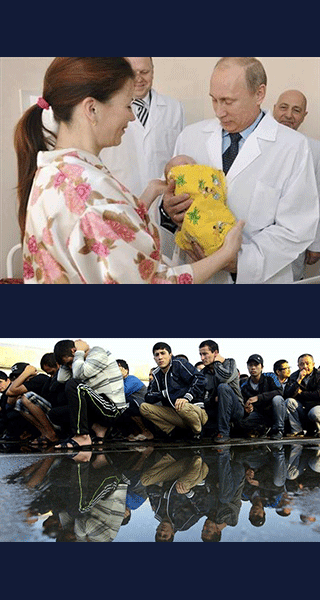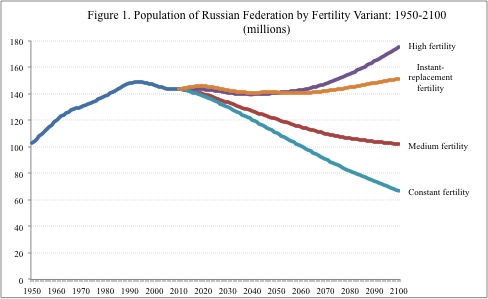Russian Demographics: The Perfect Storm
Russian Demographics: The Perfect Storm

NEW YORK: So much attention is focused on the Russian Federation’s plummeting ruble, evaporating investments and looming recession, following its land grab in Crimea and intervention in Ukraine that most are overlooking the perfect storm brewing within Russia’s borders: its demography.
The perfect demographic storm of comparatively high mortality, low fertility and emigration of well-educated professionals is increasingly burdening Russian society and its deteriorating economy. In addition to a shrinking labor force, mounting costs for its aging population and troubling premature deaths, especially among men, Russia is facing difficulties in filling critical jobs with largely unskilled non-Russian migrants, many working illegally in the country.
Throughout most of the second half of the 20th century, Russia’s population increased. Whereas the Russian population was slightly more than 100 million in 1950, it peaked at nearly 149 million by the early 1990s. Since then, the population has declined, and official reports put it at around 144 million.
The shrinking population is the result of deaths outnumbering births for nearly two decades without sufficient immigration to compensate for the deficit. The increasing number of deaths reflects the persistence of comparatively high mortality. The decreasing number of births is due to the prevailing low fertility, which plummeted to 1.2 births per woman in the late 1990s and now hovers at 1.7 births per woman. That rate is still about 20 percent below 2.1 births per woman, the level necessary to ensure population replacement.
High rates of smoking, alcohol consumption, drug use, HIV/AIDS, tuberculosis, obesity, heart disease, violence, suicide and environmental pollution contribute to Russians’ poor health. Russia’s current male life expectancy at birth of 64 years is 15 years lower than male life expectancies in Germany, Italy and Sweden.
Russia also stands out for the gap between male and female life expectancies at birth; at almost 13 years, it is one of the widest sex differentials. Moreover, the life expectancy at birth of 74 years for Russian females compares unfavorably with other developed countries, such as 80 years for Polish females.
Policies to address the health crisis are woefully inadequate. Russia’s periodic crackdown on alcohol consumption has had limited effect. About 700,000 Russians were estimated to be living with HIV/AIDS in 2013, a 5 percent increase over the previous year. With official policy forbidding opioid substitution and therapy services for drug users, HIV prevalence among Russians who inject drugs is between 18 and 31 percent.
In most European countries, where coverage of needle programs and opioid substitution therapy is high, HIV/AIDS prevalence among drug users is lower, under 17 percent. To curb smoking, estimated at 40 percent of the adult population, Russia now bans smoking in public places. In terms of health expenditure per capita, Russia ranks near the bottom among OECD countries – spending $1,474 in 2012, compared with the OECD average of $3,484.
Notwithstanding a recent fertility uptick, low fertility persists due to inadequate reproductive health services, lack of modern and low-cost contraceptives, widespread and unsafe abortions, infertility, fewer women of childbearing age, changing attitudes toward marriage and voluntary childlessness. In addition, Russia’s abortion rate, estimated at two abortions for every birth, has traditionally been the highest in the world.
Another factor mitigating against higher fertility is Russia’s high divorce rate. In 2012, for every two marriages, there was one divorce. To counter these trends, the government has sought to promote childbearing through various measures. For example, Russian families are entitled to a certificate for 429,408 rubles, $12,500, after the birth or adoption of a second child.
In 2013 the government was deliberating on whether to boost the divorce tax as a means of discouraging divorce and promoting family values. The protection of children and traditional family values was also the stated purpose for the enactment of a lesbian, gay, bisexual and transgender propaganda law to prevent distribution of "non-traditional sexual relationships" ideas among minors. The government is also considering reinstatement of a tax on childlessness, estimated at 10 percent of women in their late 40s.
Despite being home to the world’s second largest immigrant population, 11 million migrants or 8 percent of the total population, this inflow has not compensated for Russia’s population losses. These migrants, mostly from the impoverished former Soviet republics are often poorly educated and thus tend to have low paying jobs, which ethnic Russians are loathe to accept. Many migrants are from the former Central Asian Republics and the Caucasus, especially Uzbekistan, Tajikistan and Kazakhstan, and thus differ in religion, ethnicity and language from the ethnic Russian population.

Furthermore, over a third of these migrants, or some 4 million, reside unlawfully in the country and live under constant threat of harassment and deportation. The issue of illegal immigration has become so politicized that it has inflamed xenophobia and Russian ultra-nationalism, spawning numerous anti-immigration groups.
More recently, some 800,000 people, many ethnically Russian, were uprooted by the ongoing conflict in the Ukraine and have poured across the border into Russia, with various forms of status. In some cases, they receive government subsidies, as well as being relocated to other regions across Russia. Additional arrivals from Ukraine are likely, given continuing instability in the area.
Russia’s immigration policy has focused on attracting highly skilled workers from abroad, but has fallen short of its goals. Migrant labor is considered essential to counter the steep decline in Russia’s working-age population, expected to decline by 25 percent by mid-century.
Russia’s aging population has placed strains on the economy that will impact numerous sectors including agriculture, manufacturing, the armed forces and retirement schemes. In the next decade, Russia's labor force is expected to shrink by more than 12 million, or around 15 percent.
The contraction of Russia’s labor force is exacerbated by low retirement ages: 60 for men and 55 for women. In certain situations, for example, hazardous occupations or unemployment, retirement ages are lower. Nevertheless, Russia’s older population does not fare well. According to a 2014 global survey of the social and economic well-being of older people, Russia ranked 65 among 96 countries.
The future size of Russia may follow a number of scenarios, largely determined by fertility (Figure 1). For example, if fertility remained essentially constant, not an unreasonable assumption, the Russian population would fall to around 111 million by mid-century and 67 million by 2100. Such an outcome would mean that the Russian population would be less than half of its current size by the close of the 21st century.
Joseph Chamie is former director of the United Nations Population Division and Barry Mirkin is former chief of the Population Policy Section of the United Nations Population Division.
Comments
This article has made me look at a country's' population differently almost like a commodity. In China they had the problem of over population and has now reversed their one child policy. The US has used immigration to supplement our needs for manual labor from Mexico, skilled tech workers from Asia mainly but also from all over the world. You have to have certain policies to protect your people be it labor laws, health law, and now in the US more protectionist laws. Pretty cool.
So essentially this an article that discusses the problems that Russia has with its loss of population; problems that are admittedly exacerbated by excessive abortion, high divorce , and women failing to have or want more children.
Yet, despite the fact that these issues were created by sixty years of social re-engineering, based on Marx's concepts (the basis of sociology in not just the Western world, but in the USSR as well), it is implied that these issues could be at least mitigated if not solved by even more social Marxism. The cause of these problems is presented as the solution, which is not just a bad idea, but invalidates the idea itself. Calling for reproductive choice, etc, is why Russia is in the situation it is in today.
Of course, this article willingly attacks the Russian reluctance to accept immigrants as part of their society. It is almost implied that Russia should fix these issues by importing millions of non-Russians, of a different race and religion, while encouraging even more social Marxism among the ethnic Russian population.
Russia, unlike the United States, is not going to willfully commit demographic suicide; while there may be less Russians in 2100 than there were even in 1950, the population will remain
Russian. Russia has no desire to become the social Marxist multicultural dumping ground that is the United States; Russia already tried having a multi-racial, multi-sectarian Marxist society, and it failed.
It never fails to surprise me how many educated people in the United States seek to bring in a system that does not work; social Marxism is the reason why the USSR failed.
Well said. Both Marxism & Fascism are Bankster projects for world depopulation & world domination.
Book: Pawns in the Game, by William Guy Carr. Online: www.bibliotecapleyades.net/sociopolitica/pawns_inthegame/pawns_00.htm
Book: The Creature from Jekyll Island, by G. Edward Griffin. Newsletter: needtoknow.news
IMHO, the US has been pushed toward socialism/ Marxism/ Fascism since WWII, & is now in serious decline.
If Trump can halt this decline, restore rewards for free enterprise, cut the free rides for huge corporations, get away from the war economy & war mentality, then the US MAY prosper.
Else it is doomed.
US is hugely, ridiculously indebted & through overprinting for purposes of war & domination, the $US has devalued from the 1913 inception of the criminal Federal Reserve System, to a value now of less than 5 cents. No wonder Russia & China are on the brink of establishing a currency system independent of the toilet-paper $Petrodollar.
I wish China & Russia well in their progress projects, & I hope US recovers some sanity & prosperity.
John Doran.
This article and these statistics paint an entirely negative picture of Russia.
One that I haven't seen in my many travels there.
You know that In The Russian Federation, 11% of the population lives below the poverty line? "Grand country..." and that in Russia only Moscow and st.Petersburg has posibilities for normal live? Read some different sources to know what are you talking about... At least one new for you >>
http://www.confiduss.com/en/jurisdictions/the-russian-federation/demogra...
Thank you for a very informative article, it introduces a picture I have never heard before (meaning that I usually hear the opposite point of view).
Thanks for a very informative article
I dont know why. but thats big problem for all russians. But there is a lot workers, big land. But they need repair all country And its big. thats why they have this situation?
http://www.confiduss.com/en/jurisdictions/the-russian-federation/demogra...
Stalin killed a million Russians from 1924 to 1953 because of purges. WWII resulted in 25-27 million deaths. If Russia had not had a revolution and WWI and WWII they might have a population of over 300,00,000.